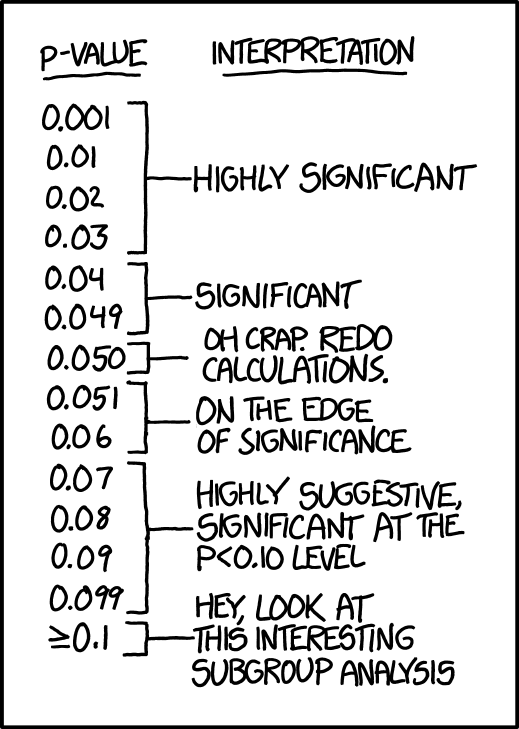Welch Two Sample t-test
data: body_mass_g by species
t = -20.628, df = 170.4, p-value < 2.2e-16
alternative hypothesis: true difference in means between group Chinstrap and group Gentoo is not equal to 0
95 percent confidence interval:
-1471.440 -1214.416
sample estimates:
mean in group Chinstrap mean in group Gentoo
3733.088 5076.016 Environmental Data Analysis and Visualization
Warm-up exercise

On Canvas, there is a link to a survey for the ENVS Society. Please take a few moments to fill this out.
Visualization Critique

Visualization Critique
Visualization Critique

Some things I heard last night
- Is it OK if I don’t have a significant relationship?
- Do I need to revise my project if I can’t answer my question with the data?
- What if my results don’t show anything exciting/interesting?
Science
Science fails
Science fails all
Science fails all the
Science fails all the time
Science fails all the time.
Science fails all the time.
And that’s OK.
Does this mean I asked a bad question?
Does this mean I asked a bad question?
No.
Does this mean I asked a bad question?
No. Developing research questions takes time and practice. But they should never be asked with the expressed aim of getting a “significant” result.
Perverse incentives


Fail productively

A negative result is a result nonetheless.
If your assumptions/predictions didn’t work out, ask why not.
If your results are inconclusive, ask what data might be needed.
How does your result compare with other studies?
Fail productively, fail gloriously
“To fail productively, one has to be aware of the multiple contexts of that fail to find the valuable experience. To fail gloriously is to use the privileges that you have, as you are able, to make it safe for others to fail.” - Shawn Graham, Failing Gloriously
Reporting the results of a statistical test
When reporting the results of a statistical test, be sure to include the following information at a minimum within the context of the hypothesis:
Name of test and variable(s)
Test statistic(s) (letter will vary)
Degrees of freedom (df)
P-value (p)
Reporting the results of a statistical test
Reporting the results of a statistical test
“I used Welch’s two-sample t-test of the body masses for Gentoo and Chinstrap penguins, and rejected the null hypothesis that there is no difference in mean body mass between these two groups (t=-20.62, df=170.4, p<2.2e-16).”
Image file formats

Jif / Giphy
Image file formats
There are two main types of image formats
Bitmap (also known as raster)
Vector
Bitmap vs Vector

Wilke, C. 2019. Fundamentals of Data Visualization
Bitmap vs Vector

Wilke, C. 2019. Fundamentals of Data Visualization
Bitmap vs Vector
Bitmap
Sharpness depends on resolution and size
Consistent appearance across platforms
Best for complex images (photos, large numbers of elements)
Vector
Sharpness is scale-independent
Can look differently using different programs
Best for simple images (line drawings, simple graphs)
Image file formats
| File Extension | Type | Use For |
|---|---|---|
| .jpg | Bitmap | Photos |
| .png | Bitmap | Line Drawings |
| .tif | Bitmap | |
| .svg | Vector | Line drawings (online) |
| Vector | General purpose |
Next week
Tuesday: Final lecture
Wednesday: Final final project development session
Thursday: SUBMIT POSTERS BY NOON, present at 4:30 PM